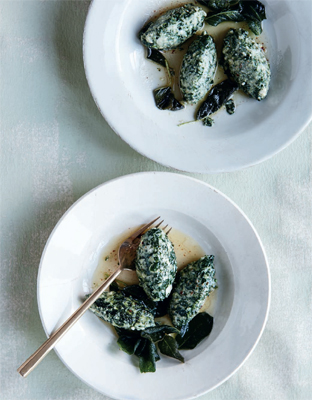
This is a fine, delicate dish of light ricotta and spinach dumplings, originating from Florence. Once shaped, the quenelles can be kept in the fridge for 24 hours before cooking, so you can make them a day ahead. Once cooked, however, they must be served at once and eaten without delay, as with a soufflé.
SERVES 8–10
30ml extra virgin olive oil
700g spinach leaves, stalks removed, washed and well drained
1 garlic clove, peeled and halved
350g ricotta (sheep’s or cow’s), well drained
80g Parmigiano Reggiano, freshly grated
1 medium egg
50g ‘type 00’ flour, plus extra for dusting
Freshly grated nutmeg, to taste
150g butter
2 or 3 sage sprigs
Fine sea salt and coarsely ground black pepper
For the fried sage garnish
A bunch of sage, leaves stripped from the stalks, rinsed and drained
A little grapeseed oil, for frying
Heat half the olive oil in a large frying pan over a medium heat. When it is hot, add half the spinach, put the lid on and cook for 2–3 minutes, stirring every 30 seconds with a fork onto which you have pronged a half garlic clove. Once cooked, tip into a colander placed over a bowl.
Repeat to cook the rest of the spinach, using the remaining oil and the other half garlic clove, then set aside in the colander to cool.
As soon as the spinach has cooled, tip it into a very fine chinois and press down on it with a plastic spatula or the back of a spoon, to extract as much water as possible. Tip the spinach onto a board and chop roughly (though if using baby leaves, this won’t be necessary).
Put the ricotta and spinach into a bowl and mix well with a wooden spoon. Shower in 50g of the Parmesan, then add the egg and shower in the flour. Mix until well combined and season with salt, pepper and nutmeg to taste.
Using 2 large spoons, shape the mixture into quenelles, about 30g each. To do this, take a heaped spoonful of the mixture and pass it repeatedly between the spoons, turning and smoothing the sides as you do so, then carefully place on a generously floured sheet of baking parchment or greaseproof paper. You should have about 36 in total. Dust with a little flour, cover loosely with cling film and set aside in a cool place until ready to cook.
To cook the gnudi, fill a large pan with water, add salt and bring to the boil. Add the quenelles to the water and poach at a bare simmer (the water should be at 80–90°C) until they rise to the surface, which indicates that they are cooked; this will take about 5 minutes. Carefully lift out the gnudi using a slotted spoon and drain, then gently place on a clean tea towel.
For the garnish, pat the sage leaves thoroughly dry. Heat a little grapeseed oil in a frying pan, then fry the sage leaves in batches (6–8 at a time) for about 5 seconds. Remove and drain on kitchen paper; the leaves will crisp up as they cool.
To finish the gnudi, have your warmed serving plates ready. Heat the butter with the sage sprigs in a large frying pan. As the butter starts to foam and take on a nutty brown colour, add the gnudi, making sure they are not too close together. Cook for 1 minute, then carefully turn them over and cook on the other side for a further minute.
Place 3 gnudi on each warmed plate. Arrange the fried sage leaves around the gnudi, dust with the remaining 30g Parmesan and serve.